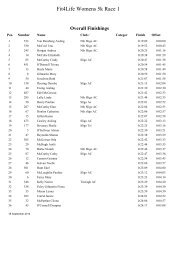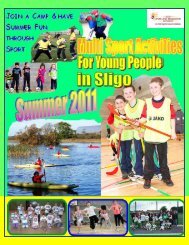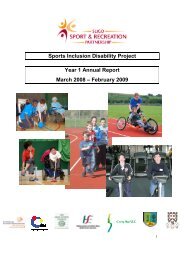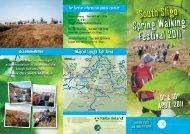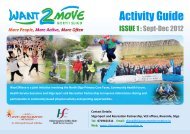Girls Active Programme - Sligo Sport and Recreation Partnership
Girls Active Programme - Sligo Sport and Recreation Partnership
Girls Active Programme - Sligo Sport and Recreation Partnership
Create successful ePaper yourself
Turn your PDF publications into a flip-book with our unique Google optimized e-Paper software.
Discussion<br />
linked with local facilities such as riding clubs.<br />
The development of relationships such as these<br />
makes it easier to locate instructors <strong>and</strong> has the<br />
added attraction for girls of being located outside<br />
the school grounds. It may also help to counter<br />
the perception of girls that there are no suitable<br />
facilities for physical activity available to them<br />
outside of school.<br />
5.3 Impacts<br />
5.3.1 Participating <strong>Girls</strong><br />
In the questionnaire, most girls identified a number of<br />
beneficial effects that participation in the programme<br />
has had on them personally such as feeling better,<br />
being more active, learning new activities <strong>and</strong> being<br />
more aware of general health. A large proportion of<br />
girls also identified other positive impacts such as<br />
feeling more confident, studying better <strong>and</strong> joining<br />
new clubs. In addition, there are indications from<br />
the questionnaire data that participation in the<br />
programme has led to a response from the girls<br />
in relation to their participation in other physical<br />
actvities outside of <strong>Girls</strong> <strong>Active</strong> such as showing<br />
more interest in school PE classes or in taking up<br />
other sports/ activities.<br />
The evidence from the case studies reinforces these<br />
findings <strong>and</strong> builds on them by suggesting that a<br />
group bond develops among girls participating on<br />
the programme, that the fun element is central to<br />
the experience <strong>and</strong> that the programme provides<br />
an opportunity for girls to get to know others from<br />
different classes <strong>and</strong> to develop their relationships<br />
with the co-ordinating teachers. Discussion in the<br />
focus groups revealed that the girls had quite a high<br />
awareness of the issues pertaining to teenage girls<br />
<strong>and</strong> physical activity - in one case, for instance, they<br />
suggested that younger more active girls should be<br />
facilitated to join <strong>Girls</strong> <strong>Active</strong> so that they would<br />
maintain good activity habits that might persist<br />
through later years. It is unclear to what extent this<br />
awareness is a direct result of their participation on<br />
the programme, but it is possible that the issue may<br />
have been addressed in the linked SPHE class.<br />
The girls identified certain barriers to their<br />
participation in further physical activity - not having<br />
the time (questionnaire) <strong>and</strong> not having access to<br />
facilities or clubs (case studies). The former may<br />
suggest that girls place a relatively low priority on<br />
physical activity <strong>and</strong>/or that significant dem<strong>and</strong>s<br />
are made on girls’ spare time from home duties,<br />
long journeys to/from school, other activities <strong>and</strong> so<br />
on. The lack of facilities reflects the fact that many<br />
of the girls live in rural areas where recreational<br />
clubs may not be accessible <strong>and</strong> may not provide<br />
the kind of facilities or activities that are attractive<br />
to them.<br />
5.3.2 Participating Schools<br />
The experience of the case studies suggest<br />
that, having successfully implemented <strong>Girls</strong><br />
<strong>Active</strong> over a number of years, the programme is<br />
becoming embedded in participating schools <strong>and</strong><br />
managements are intent on maintaining it in the<br />
long term even without the back-up of the support<br />
organisations.<br />
The case studies also give an indication of the<br />
extent of some wider effects of <strong>Girls</strong> <strong>Active</strong> in the<br />
participating schools. Despite some initial ‘slagging’<br />
from other students it appears that the programme<br />
has a positive association generally within the<br />
student body of participating schools <strong>and</strong> many<br />
non-participating girls have expressed interest in<br />
joining it. Initiatives such as presenting <strong>Girls</strong> <strong>Active</strong><br />
girls with certificates at the end-of-year prize-giving<br />
day or allowing them to wear their sports kit for<br />
the day of <strong>Girls</strong> <strong>Active</strong> activity helps to promote the<br />
attractiveness of the programme for other girls <strong>and</strong><br />
to heighten its visibility within schools.<br />
All three of the principals that were interviewed<br />
linked the programme to other ongoing in-school<br />
initiatives such as Healthy Eating or Healthy<br />
Schools porgrammes. Both principals <strong>and</strong> coordinators<br />
exhibited a good underst<strong>and</strong>ing of the<br />
issues for teenage girls in relation to physical<br />
activity, although to what extent this level of<br />
underst<strong>and</strong>ing is a product of participating in <strong>Girls</strong><br />
<strong>Active</strong> or a contributory factor towards the schools’<br />
participation in the first instance is difficult to say.<br />
Evaluation of the <strong>Girls</strong> <strong>Active</strong> <strong>Programme</strong> - 2003 – 2005 Report 29



